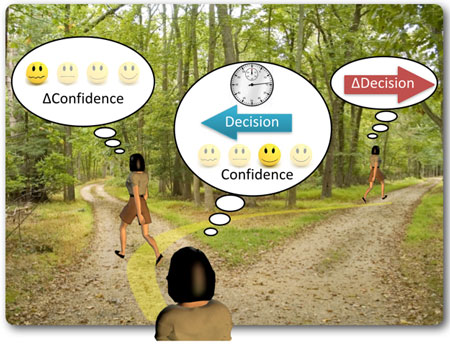Recent progress in the neurobiology of perceptual decision making has served to unite decision accuracy, speed and confidence in a common framework of bounded evidence accumulation. In a well-studied task in which a participant must judge whether a set of dots displayed on a screen is moving to the left or the right, the decision itself is governed by the accumulation of noisy (i.e random) samples of evidence from the visual stimulus. The accumulation is represented by neurons in the association cortex of the brain such that their firing rate is proportional to the sum of the evidence for one choice versus the other. This representation, termed a decision variable, is compared to a threshold, which terminates the decision process, thereby establishing both the choice and decision time. The latter corresponds to the measured reaction time, but there are processing delays that separate these events by enough time to allow for a dissociation between the state of accumulated evidence used to terminate the decision and the evidence used to support subsequent behaviors. Confidence is informed by a mapping between the state of the neural representation of accumulated evidence used to make the decision and the likelihood that it would support a correct choice.

Van den Berg et al bring to light a particularly compelling example of this dissociation. Participants performed the motion direction discrimination task. Whenever ready, the subject moved a handle from the center of a square to one of four choice targets on the vertices, thereby indicating simultaneously the direction decision (left and right targets) and confidence level (top and bottom targets). On most trials subjects made an approximately straight-line movement to one of the choice targets. However, although the dots were extinguished on movement onset, on a proportion of trials subjects changed their choice or confidence rating or both, initially reaching towards one target but deviating to reach another. They went on to show that a common mechanism explains the rate of these occurrences, as well as the speed, accuracy and confidence in the subjects’ initial decisions. The key idea is that although the subjects committed to a decision and associated confidence when initiating their movement, because of delays in the system, they continued to accumulate further information in their processing pipeline and this could cause them to revise their confidence, choice or both.
The study makes three conceptual advances in our understanding of the neural mechanisms that underlie a decision maker’s confidence in his or her choice. (1) It supports a unifying framework—bounded evidence accumulation—to explain accuracy, speed (reaction time), confidence and changes of mind about a decision. It is the first to show that confidence exhibits the same type of vacillations (changes of mind) that a decision does, and for related reasons. (2) It furnishes a simplifying principle that challenges an increasingly popular psychological notion, termed metacognitive confidence, which highlights a dissociation between evidence-based mechanisms that support choice and confidence. It shows that this dissociation can be explained by “changes of mind” about confidence, and that such changes of mind are not mysterious but supported by evidence-based mechanisms. (3) It extends our understanding of the linkage between sensory and motor systems in the service of cognitive function. The study also shows that the processes involved in ongoing evaluation of evidence influence evolving motor processes, reflecting a continuous update of both belief and action planning.
Reference
A common mechanism underlies changes of mind about decisions and confidence. van den Berg, R, Anandalingam, K, Zylberberg, A, Kiani, R, Shadlen, MN, Wolpert, DM. (2016) Elife, 5:e12192.


































